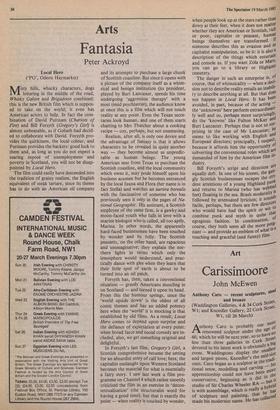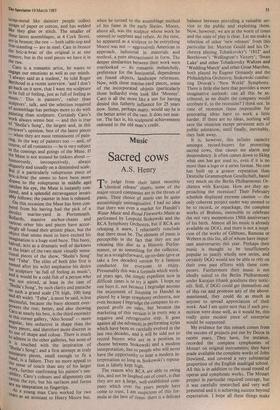Art
Carissimoore
John McEwen
Anthony Caro — recent sculptures, steel and bronze (Waddington Galleries, 4 & 34 Cork Street, WI; and Knoedler Gallery, 22 Cork Street, WI, till 26 March)
Anthony Caro is probably our most, renowned sculptor under the age t 60, which he will be next year, so to have ° less than three galleries in Cork Street devoted to his latest work is obviously a big event. Waddingtons display the smallest and largest pieces, Knoedler's the mid ones. Caro began as a sculptor in the tra,".1: bona' sense, modelling and carving — apprenticeship could not have been more conservative, beginning as it did in th studio of Sir Charles Wheeler RA — but i is with assemblage, which is really a by hr of sculpture and painting, that he 11;i made his modernist name. He has collect scrap-metal like daintier people collect scraps of paper or cotton, and has welded like they glue or stitch. The smaller of these latest assemblages, at 4 Cork Street, are in bronze; the rest — both table-top and free-standing — are in steel. Cast in bronze the bric-a-brac of the original is at one remove, but in the steel pieces we have it in the raw.
Caro is a romantic artist, he wants to engage our emotions as well as our minds. I always said as a student,' he told Roger Berthoud in a recent interview, 'and I don't go back on it now, that I want my sculpture to be full of feeling, just as full of feeling as music.' This is painters', rather than sculptors', talk, and the selection required of assemblage has perhaps more to do with Painting than sculpture. Certainly Caro's Work always seems best — and this is true or 'Sheila's Song', the largest and, in this reviewer's opinion, best of the latest pieces ---, when they are most reminiscent of pain- ting. In the way of painters too — and, of Course, of all romantics — he is very subject to the comings and goings of the Muse. If the Muse is not around he tinkers about - humorously, introspectively, always elegantly and usually on a diminished scale. tBut if a particularly voluptuous piece of uric-a-brac (he seems to have been more drawn to the voluptuous in middle age) catches his eye, the Muse is instantly con- lured, and a splendid extravagance invari- ably follows; the painter in him is released. On this occasion the Muse has been con- futed from his having had the pick of a derelict marine-yard in Portsmouth. Bollards, massive anchor-chains and various other bits and pieces have accor- dingly all found their artistic place, but the object that seems most to have excited his halgtnation is a huge steel buoy. This buoy, ed,acts as a dramatic well of darkness at the heart of the two most visually sensa- tt°11al pieces of the show, 'Sheila's Song' and 'Tuba'. The titles of both (the first is named after his wife) emphasise his desire for sculpture 'as full of feeling as music'; and it would be a cold fish of a person who was not stirred, at least in the case of Sheila's Song', by such clarity and panache °II such a grand scale (7ft high, loft long and 4ft wide). 'Tuba', it must be said, is less successful, because the buoy element over- powers the rest; better, and also showing faro at nearly his best, is the third enormity rn this corner gallery, 'Alto Sound' — more angular, less seductive in shape than the 11°Y Pieces, and therefore more discreet in its use of shape and colour. There is much io admire in the other galleries, but none of ,t„ is touched with the inspiration of Sheila's Song'; and a first attempt at truly hand, pieces, small enough to fit a tLarld, is a failure. They no more appeal to wile sense of touch than any of his larger s.(2rk. , further confirming his painter's sen- ,,IcIthtY. Caro's colours and alignments Can ravish the eye, but his surfaces and forms are no temptation to fingertips. As a Young man Caro worked for two y'ear's as an assistant to Henry Moore but,
when he turned to the assemblage method of his fame in the early Sixties, Moore, above all, was the sculptor whose work he seemed to supplant and refute. At the time, he appeared as a sculptor to be everything Moore was not — aggressively American in approach, industrial in materials and method, a pure abstractionist in form. The deeper similarities between their work were overlooked — its romantic melancholy, preference for the horizontal, dependence on found objects, landscape references. Now, with these marine-yard pieces, some of the incorporated objects (particularly those bollards) even look like 'Moores'. Caro is all the more like a son for having denied this fatherly influence for 25 years now. Some, perhaps many, would say he is the better artist of the two. It does not mat- ter. The fact is, his sculptural achievements redound to the old man's credit.











































 Previous page
Previous page